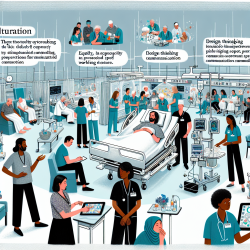Introduction
In the high-stakes environment of the Intensive Care Unit (ICU), effective communication is not just beneficial; it is essential. The recent study titled "Understanding equitable and affirming communication moments and relationship milestones during the intensive care unit journey" offers valuable insights for practitioners aiming to enhance their communication skills and improve patient outcomes. This blog explores the findings of the study and how they can be applied in practice to foster better communication and relationships in the ICU setting.
Key Findings from the Study
The study utilized a design thinking approach to identify critical communication moments and relationship milestones within the ICU journey. By conducting journey mapping interviews with ICU healthcare providers, patients, and their loved ones, the researchers defined 16 key communication moments and relationship milestones. These include:
- Initial interactions with the ICU team
- Transition into the ICU
- Decision-making junctions
- Moments of connection and acknowledgment of identity and values
These moments are crucial in building trust and facilitating patient and family-centered care (PFCC). The study emphasizes the importance of considering Equity, Diversity, Decolonization, and Inclusion (EDDI) in communication strategies to create an affirming and culturally safe environment.
Applying the Findings in Practice
For practitioners, the study's findings highlight the need to be mindful of diverse intersectional identities that impact communication and relationships in the ICU. Here are some actionable steps to implement these insights:
- Embrace EDDI Principles: Incorporate equity, diversity, and inclusion into everyday communication practices. Recognize and affirm the diverse identities of patients and their families to build trust and rapport.
- Enhance Cultural Competency: Engage in continuous learning about different cultural practices and beliefs. This knowledge can help in understanding patient needs and preferences, leading to more effective communication.
- Utilize Technology Wisely: Leverage communication technologies to bridge gaps, especially for patients and families who cannot be physically present. Ensure that these technologies are accessible and user-friendly for all.
- Foster a Safe Environment: Create spaces where patients and their loved ones feel comfortable to express their needs and concerns. This involves being present, genuine, and empathetic in interactions.
Encouraging Further Research
While the study provides a foundational understanding of communication in the ICU, there is room for further exploration. Practitioners are encouraged to engage in ongoing research to refine communication strategies and develop innovative solutions that address the evolving needs of diverse patient populations.
Conclusion
Effective communication in the ICU is a dynamic and complex process that requires sensitivity to the diverse identities and experiences of patients and their families. By applying the insights from this study, practitioners can enhance their communication skills and contribute to better patient outcomes. For those interested in delving deeper into the research, the original study offers a comprehensive exploration of these critical issues.
To read the original research paper, please follow this link: Understanding equitable and affirming communication moments and relationship milestones during the intensive care unit journey: findings from stage 1 of a design thinking project.










